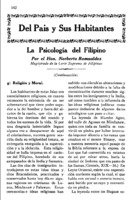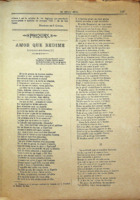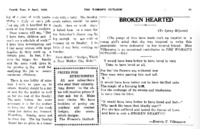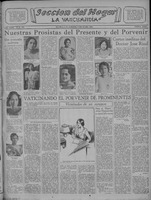A discussion on the Babaylan from a medical perspective
The role of women in the Philippines has been historically entangled with writing. In the indigenous tradition, babaylan, or women shamans, were healers and wisdom keepers. An article of 1926 noted how they healed their patients with Buloñg, or the whispering of sacred words.
Although Christianity imposed itself on the babaylan tradition and these woman-healers gradually disappeared during the Spanish colonization, the word was also important in Christianism. Religious women (nuns) did write. There is actually a project developed at the Spanish Open University called "Bieses", on communities of nuns writing in Spanish up to 1800, which does include Philippine communities. Thus, many religious women left as a legacy accounts of miracles, colorful reports of their daily lives at the missions, and even chronicles of their experiences during the Philippine revolution. Some of these writings were included in the newspapers.
For their part, some women like Leona Florentino continued the tradition of indigenous writing outside the Christian religion during the 19th century. Leona Florentino was a polyglot Ilocano writer. We preserve some of her poems because her son, Isabelo de los Reyes, translated them and included them in his work El folk-lore filipino.
In the 19th and 20th centuries, women's writings were crucial to conceptualize the Philippine nation and the history of Philippine feminism. At the end of the 19th century, Spanish women started to write in Philippine newspapers and publish their fiction and poetry proposing their ideas on the role of the Filipina in society. These narratives portrayed a Christian view of the women's social role but, at the same time, although still reproducing a colonial mentality, their discourse was deviant from the male’s colonial sexualization of the conquest and the Indigenous woman (McClintock 1995; Pratt 1992). The presence of these fictions in the first women's magazines and their circulation in educational establishments until the early 20th century ensured that they reached the next generation of Philippine women writers.
Enriqueta Lozano, “Amor que redime"
After the American invasion, there was a peak in women’s associationist movements and in the creation of magazines for women (Reyes Encanto 2004; Villaescusa 2022). These associations and magazines promoted a triple insertion, this time of Philippine women in the public sphere: (1) through the suffragist movement and the involvement of women in the independence of the nation, (2) through the promotion of charity work as a social obligation of women to contribute to the progress of their country, (3) through the postcolonial writings that combined stressing the importance of precolonial identity and the inspiration in foreign countries to advance the development of the Philippines in a modern (westernized) world.
Initially, literary pieces written by women were published either in the “Home” section of most newspapers or in magazines devoted to a feminine public, such as La mujer, The Woman’s Outlook, The Woman’s Home Journal, The Weekly Women’s Magazine or The Woman’s World.
"De puertas adentro", by Margaret Culkin Banning
"Broken Hearted", by Rosario Villanueva
The Woman’s Outlook was a bilingual weekly publication in English and Spanish that mostly displayed opinion editorials on different issues of interest for Filipino women of the 1920s, such as suffragism, education, and charity. The magazine also published literary pieces from both international and local writers. As for international women authors, texts by writers of the stature of Margaret Culkin Banning, an early advocate of women's rights in the United States, were also featured. Her short story “De puertas adentro” was published in Spanish translation in the pages of The Woman's Outlook, in the “Sección castellana” edited by Pura Villanueva Kalaw (1926).
The English section of this magazine published mainly literary works written by men about women, but, despite the early days of the period - we should bear in mind that education in English had not reached the archipelago until 1902 - some poems and texts in English written by women already appeared in the 1920s
Nuestras Prosistas del Presente y del Porvenir
By those days, and especially from the early 1930s women were starting to be appreciated as skillful writers in all the languages of the archipelago. Interestingly, in the listings of women writers appearing in books and press, they would include women who had published no books, but just articles, discourses, or editorials in newspapers. Some of the highlighted authors of narrative in the 1930s were Rosa Sevilla de Alvero, Alicia Palma, Celia Canseco, Natividad Almeida de López, and Paz Mendoza Guazón.
Dr. Mendoza Guazón was a strong political and feminist activist who traveled around the world publishing her chronicles in various Philippine newspapers (Mendoza Guazón 1930; Villaescusa 2018). Another famous writer in Spanish was Evangelina Guerrero. She promoted an image of the Filipina as deviant from the María Clara stereotype idealized by men in her tales published in Excelsior. Philippine feminism was, however, a transcultural women’s movement that distilled local, colonial, and international sources in its identity (Villaescusa 2020).
Bibliographic references
Villaescusa, Irene. 2018. “Un paseo por la modernidad: reflexiones de Paz Mendoza en sus Notas de viaje (1929)”, Revista de Crítica Literaria Latinoamericana 44, num. 88: 267-90.
Escondo, Kristina. 2019. “Recuperating Rebellion Rewriting Revolting Women in(to) Nineteenth-Century Cuba and the Philippines”. Unitas 92(1). 75-112.
Guerrero Zacarías, Evangelina . 1932. “Espejo sentimental”. Excelsior, 20 November 1932.
Encanto Georgina Reyes. 2004. Constructing the Filipina : A History of Women's Magazines 1891-2002. Quezon City: University of the Philippines Press.





